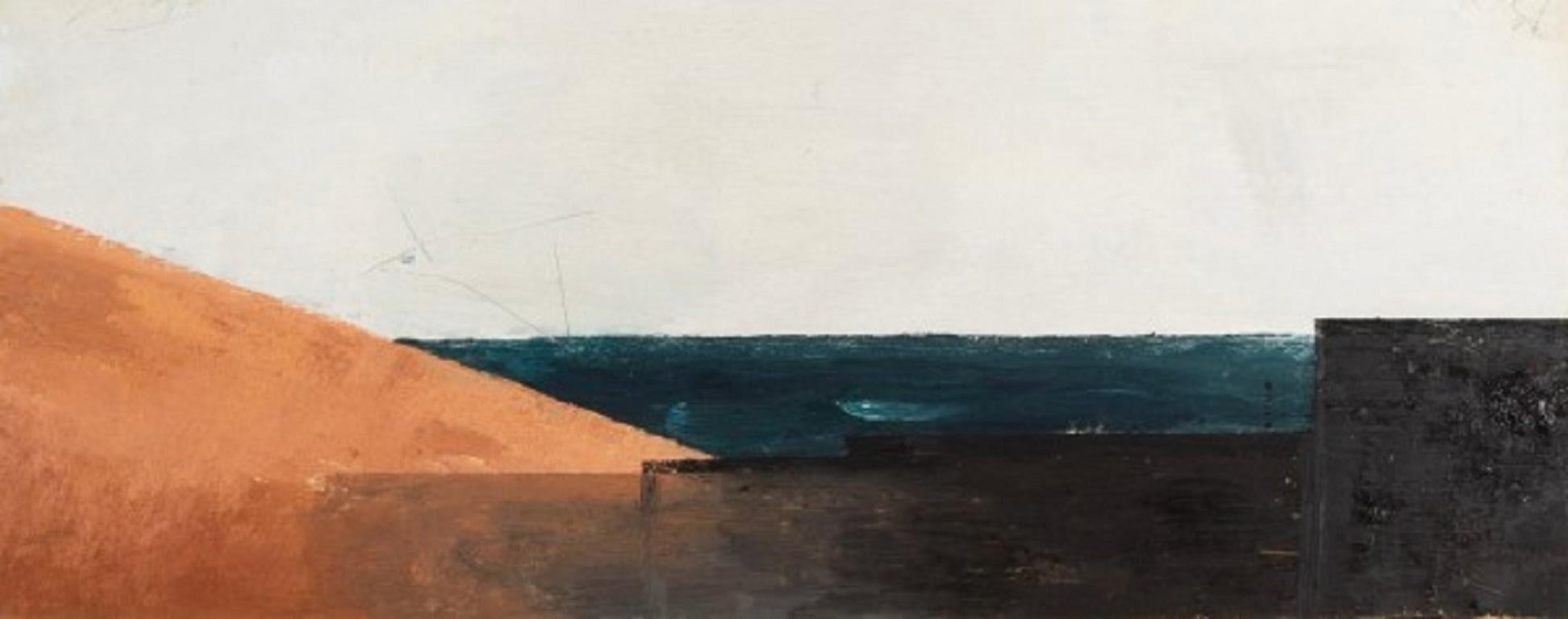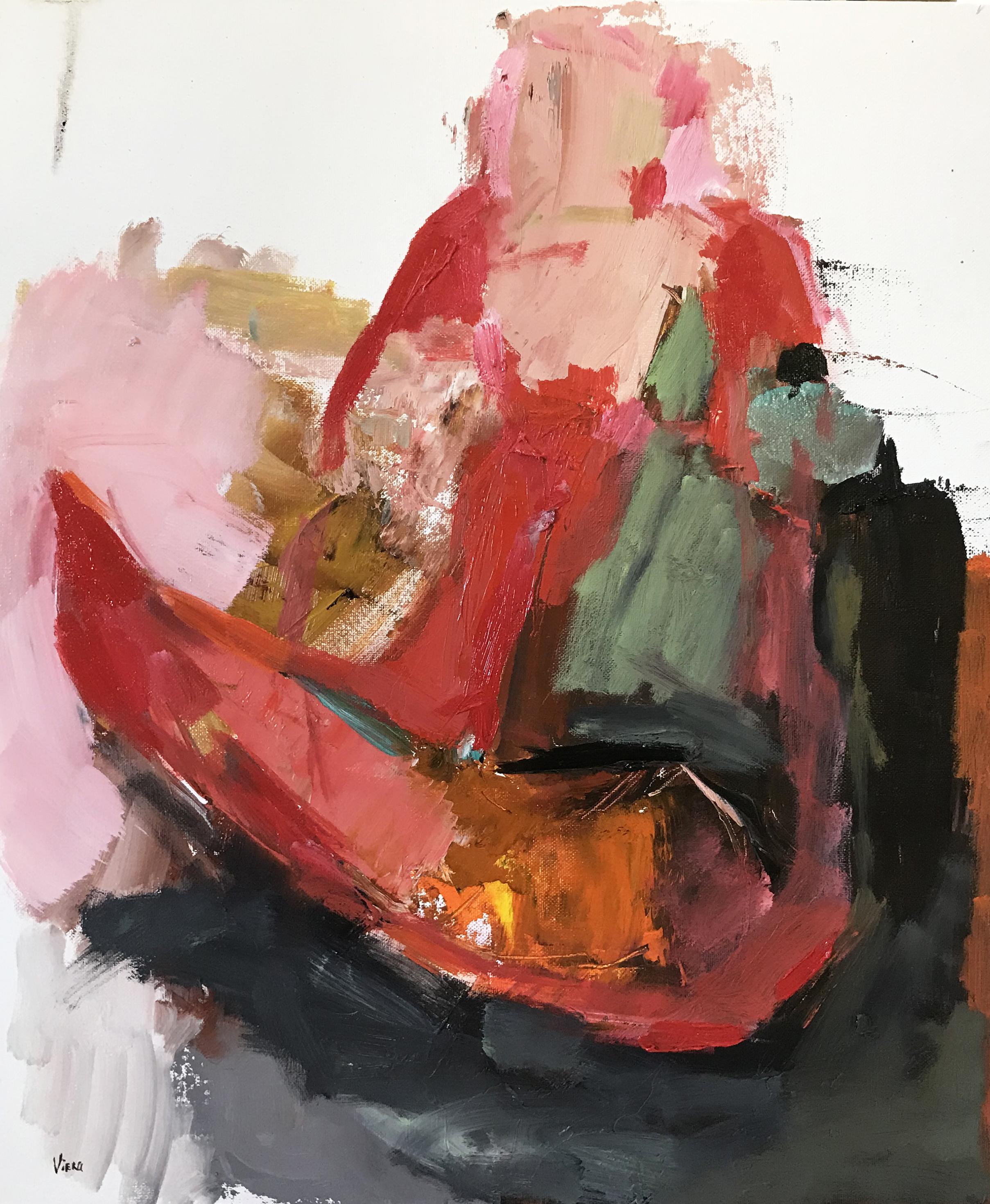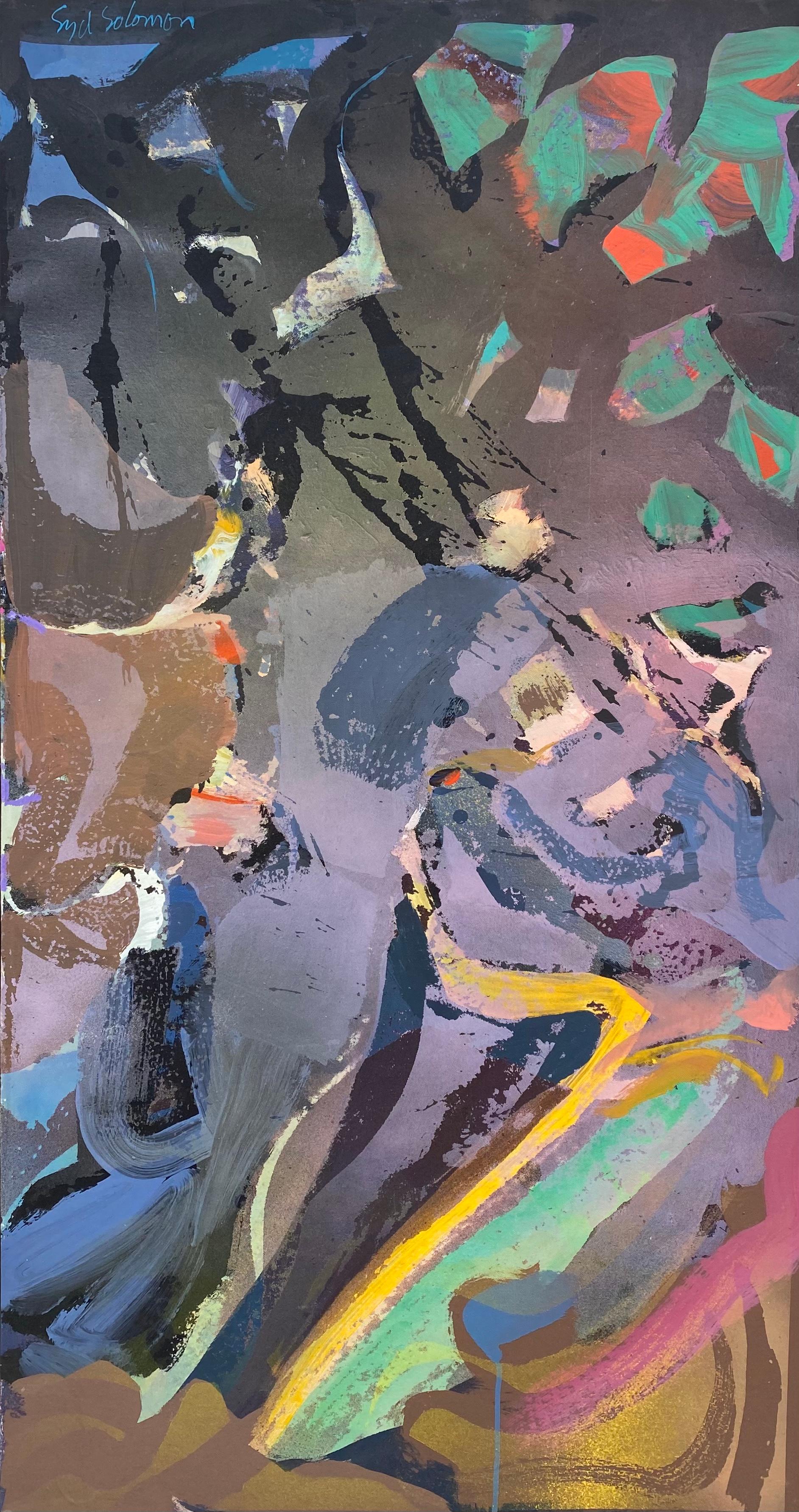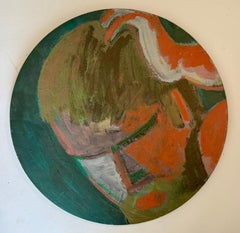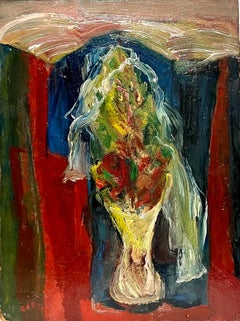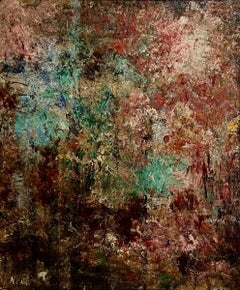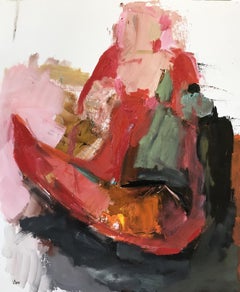Items Similar to Modernist Mexican Artist "Porters Garden" Abstract Expressionist Oil Painting
Want more images or videos?
Request additional images or videos from the seller
1 of 9
Ernesto LinaresModernist Mexican Artist "Porters Garden" Abstract Expressionist Oil Painting
About the Item
Genre: Modern
Subject: Abstract
Medium: Oil
Surface: Board
Dimensions: 16" x 19 3/4" x 1/4"
Dimensions w/Frame: 19 1/4" x 23 1/4"
Ernesto Linares Early Mexican Modernist Abstract Expressionist.
Mexican artist Ernesto Butterlin Linares, “Lin,” had close ties with Ajijic and was active in the 1940s and 1950s. Ernesto’s parents and his two older brothers were born in Germany and moved to Mexico in 1907, sailing 1st class aboard the “Fürst Bismarck” of the Hamburg-America line, from Hamburg to Veracruz. The family settled in Guadalajara, and also owned a huerta orchard near Ajijic. By the early 1940s, Ernesto, now in his twenties and using the name Linares for his art, is living and painting year-round in Ajijic. From about 1943 to 1945, he shared his village home with American artists Charmin Schlossman Lanier and Sylvia Fein, whose husbands were on active military service overseas. American writer Neill James first moved to Ajijic in September 1943 and in an early article about the village described Linares as a “young Mexican abstract painter who is currently showing his works in a traveling exhibition in the USA.” That brief description shows that Ernesto had already achieved some success as an artist, even at this early age. In about 1945, Ernesto entertained visiting American artist George Buehr (1905-1983), a professor at the Art Institute of Chicago, as his house guest. Shortly afterwards, in about 1947, American artist, anthropologist and author Tobias Schneebaum arrived on the scene. In Wild Man, Schneebaum writes, “A young blond painter, born in Guadalajara of German parents, also lived in Ajijic. He was twenty-seven, blue-eyed, four inches over six feet, and very handsome, and was subject to the attentions of both the men and the women who later passed through town…” He’d changed his Germanic name to Linares to identify more closely with the country of his birth, and liked to be called Lynn. He painted during the day with bright reds and yellows in wide bands of color, freely brushed and ripped on, a technique he claimed preceded Jackson Pollock, who he insisted had seen his work. He’d had one-man shows in New York and Mexico City.” (Wild Man, 12). Elsewhere, Schneebaum describes how Ernesto “had inherited a considerable amount of farmland on the outskirts of Ajijic, but he spent most of his time painting in a drip technique that might have preceded the work of Jackson Pollock.” (Secret Places, 7) Schneebaum, Ernesto Butterlin and a third artist Nicolas Muzenic were all employed by Irma Jonas to teach students attending her summer painting schools in Ajijic (held 1947-1949 inclusive). According to Schneebaum, an ill-fated love triangle developed between the three artists at this time, complicated by the arrival of “haughty and radiantly beautiful” Zoe, the “fourth member of our group”, who had previously been living with Henry Miller in Big Sur, when she heard about Lin and decided to visit Ajijic: “After my return to Ajijic from Mexico City, other foreigners came to stay, notably Nikolas (sic) Muzenic, with whom I fell in love. He had been a student of Josef Albers at Black Mountain College…
In about 1952, Ernesto Butterlin, in association with one or more of his brothers, opened an art gallery in Ajijic. This is the gallery pictured in the Life Magazine article (23 December 1957) about Ajijic. The “Margo de Butterlin” or “Margaret North de Butterlin” described in that article was Otto’s lover (during his marriage to Peggy); Margo married Ernesto (who was gay) in order to acquire the Butterlin surname; she appears to have provided the financial means to help establish the gallery. In Life Magazine, she is described as “both rich and fashionable”, as well as, “US-born but Mexican by her last marriage”. Disappointingly little is known of what became of most of Ernesto Butterlin’s pioneering artworks though both Ernesto and his older brother Otto were among the 28 artists given a joint exhibition in June 1954, in Mexico City, at the Instituto Nacional de Bellas Artes’ Salón de la Plástica Mexicana. Other artists whose work was featured on that occasion include Roberto F. Balbuena, Michael Baxte, Leonora Carrinqton, Enrique Climent, José Feher, Elvira Gascón, Gunther Gerzso and Carlos Mérida.
- Creator:Ernesto Linares (Mexican)
- Dimensions:Height: 19.25 in (48.9 cm)Width: 23.25 in (59.06 cm)
- Medium:
- Movement & Style:
- Period:
- Condition:
- Gallery Location:Surfside, FL
- Reference Number:1stDibs: LU38211594262
About the Seller
4.9
Platinum Seller
Premium sellers with a 4.7+ rating and 24-hour response times
Established in 1995
1stDibs seller since 2014
1,742 sales on 1stDibs
Typical response time: 2 hours
- ShippingRetrieving quote...Shipping from: Surfside, FL
- Return Policy
Authenticity Guarantee
In the unlikely event there’s an issue with an item’s authenticity, contact us within 1 year for a full refund. DetailsMoney-Back Guarantee
If your item is not as described, is damaged in transit, or does not arrive, contact us within 7 days for a full refund. Details24-Hour Cancellation
You have a 24-hour grace period in which to reconsider your purchase, with no questions asked.Vetted Professional Sellers
Our world-class sellers must adhere to strict standards for service and quality, maintaining the integrity of our listings.Price-Match Guarantee
If you find that a seller listed the same item for a lower price elsewhere, we’ll match it.Trusted Global Delivery
Our best-in-class carrier network provides specialized shipping options worldwide, including custom delivery.More From This Seller
View AllMod Abstract Expressionist Modernist Edward Avedisian Color Field Oil Painting
By Edward Avedisian
Located in Surfside, FL
Edward Avedisian
Unsigned, (bears name signed verso in pencil.)
Dimensions: 15" X 15" (round tondo)
Circa late 1970s
This is a mod, brutalist portrait of a man
Edward Avedisian (J...
Category
1970s Abstract Expressionist Abstract Paintings
Materials
Oil, Board
Mod Abstract Expressionist Oil Painting Bernard Segal New Hope PA Modernist Art
Located in Surfside, FL
Bernard Segal was born in Cincinnati, Ohio and attended Cincinnati University and the Cincinnati Art Academy. He was known for figure, abstract painting, collage, and cartoon illustration.
In the 1920's and 30's, he lived in NYC and attended The Art Students League where he was creative with a number of artistic styles of the period. During WWII, he worked as a cartoonist for a government issued newspaper called 10-SHUN that was published in Greensboro, NC. Bernard worked under the pen name Seeg, and was the author of the comic strip "Hank and Honey," that appeared in the New York Herald Tribune from the 1940's through the 50's. This cartoon was syndicated and published in Quebec under the title "Louise et Louis." The strip was later retitled to Ellsworth. Segal also illustrated a number of Jewish books that were published by the Union of American Hebrew Congregations, and Bible stories.
In the 1950's Segal moved to Bucks County, Pennsylvania, and became a member of the New Hope Modernists. He worked with esteemed artists such as George Nakashima, Charles Evans, Louis Stone, Lloyd ney, josef Zenk, Clarence Carter and Charles Ramsey.
Segal's most noted work was made during the 1960's, during which time he produced paintings and collages in the abstract expressionist style. He enjoyed painting bright abstract oil...
Category
1960s Abstract Expressionist Abstract Paintings
Materials
Oil, Board
American Abstract Expressionist Flowers Oil Painting Norman Carton WPA Artist
By Norman Carton
Located in Surfside, FL
Norman Carton (1908 – 1980) was an American artist and educator known for abstract expressionist art. He was born in the Ukraine region of Imperial Russia and moved to the United States in 1922 where he spent most of his adult life.
A classically trained portrait and landscape artist, Carton also worked as a drafter, newspaper illustrator, muralist, theater set designer, photographer, and fabric designer and spent most of his mature life as an art educator. Carton showed in and continues to be shown in many solo and group exhibitions. His work is included in numerous museums and private collections throughout the world.
Norman Carton was born in the Dnieper Ukraine territory of the Russian Empire in 1908. Escaping the turbulence of civil war massacres, he settled in Philadelphia in 1922 after years of constant flight. While attending the Pennsylvania Museum School of Industrial Art, Carton worked as a newspaper artist for the Philadelphia Record from 1928 to 1930 in the company of other illustrator/artists who had founded the Ashcan School, the beginnings of modern American art. From 1930 to 1935, he studied at the Pennsylvania Academy of Fine Arts under Henry McCarter, who was a pupil of Toulouse-Lautrec, Puvis de Chavanne, and Thomas Eakins. Arthur Carles, especially with his sense of color, and the architect John Harbison also provided tutelage and inspiration. Following his time at the Pennsylvania Academy of Fine Arts, Carton studied at the Barnes Foundation from 1935 to 1936 where he was influenced by an intellectual climate led by visiting lecturers John Dewey and Bertrand Russell as well as daily access to Albert C. Barnes and his art collection.
Carton was awarded the Cresson Traveling Scholarship in 1934 which allowed him to travel through Europe and study in Paris. There he expanded his artistic horizons with influences stemming from Henri Matisse, Pablo Picasso, Chaim Soutine, and Wassily Kandinsky. While at the Pennsylvania Academy of Fine Arts, Carton was also awarded the Toppan Prize for figure painting as well as the Thouron Composition Prize. He received numerous commissions as a portrait artist, social realist, sculptor, and theatrical stage designer as well as academic scholarships. During this time, Carton worked as a scenery designer at Sparks Scenic Studios, a drafter at the Philadelphia Enameling Works, and a fine art lithographer.
From 1939 to 1942, the Works Progress Administration (WPA) Federal Art Project employed Carton as a muralist and easel artist. He collaborated with architect George Howe. The WPA commissioned Carton to paint major murals at the Helen Fleischer Vocational School for Girls in Philadelphia, the Officers’ Club at Camp Meade Army Base in Maryland, and in the city of Hidalgo, Mexico. Throughout the 1940s, Carton exhibited and won prizes for his semi-abstract Expressionist and Surrealist paintings. He socialized with and was inspired by Émile Gauguin and Fernand Leger. During World War II, Carton was a naval structural designer and draftsman at the Cramps...
Category
Mid-20th Century Abstract Expressionist Still-life Paintings
Materials
Oil, Board
Abstract Expressionist Textured Art Informel Oil Painting Signed Noel
By Georges Noel
Located in Surfside, FL
As there are no labels and this came out of an estate I am selling this as an attribution. It is a lovely piece reminiscent of Jean Dubuffet and the American Abstract Expressionism of Milton Resnick.
Frame measures 28 X 24 board measures 24 X 20.
Georges Noel...
Category
20th Century Abstract Expressionist Abstract Paintings
Materials
Oil, Board
Charles Clough Picture Generation Abstract Expressionist Oil Enamel Painting
By Charles Clough
Located in Surfside, FL
This listing is for 1 painting. the last image shows all 4 that I have hung as grouping.
Charles Sidney Clough (born February 2, 1951, in Buffalo, New York) is an American painter. H...
Category
1980s Abstract Expressionist Abstract Paintings
Materials
Enamel
Charles Clough Picture Generation Abstract Expressionist Oil Enamel Painting
By Charles Clough
Located in Surfside, FL
This vibrant colorful painting is fully hand signed, dated and titled verso.
It might be acrylic but it looks like oil or enamel ad I have seen it described thusly.
This listing is...
Category
1980s Abstract Expressionist Abstract Paintings
Materials
Enamel
You May Also Like
Flight, Oil and Sand on Board, Abstract Horizontal Landscape Painting, 2006
By Keith Purser
Located in Kingsclere, GB
Flight, Oil and Sand on Board Painting by Keith Purser b 1944, 2006
Additional information:
Oil and sand on board
Dimensions: 12 1/4 x 29 7/8 in
31 x 76 cm
(KP523)
Category
21st Century and Contemporary Abstract Expressionist Abstract Paintings
Materials
Board, Oil
Abstract still life. Oil on cardboard, 85x74 cm
Located in Riga, LV
Aleksandr Rodin (1922-2001)
Painter Born in a family of farmers. Wife Rasma Lace - art scholar. Studied at the Stalingrad School of Art, Saratov Art School, graduated from the Depar...
Category
1980s Abstract Expressionist Still-life Paintings
Materials
Oil, Cardboard
Moldovan Contemporary Art by Doïna Vieru - Untitled
By Doïna Vieru
Located in Paris, IDF
Oil on cardboard marouflaged on canvas
Category
2010s Abstract Expressionist Abstract Paintings
Materials
Canvas, Oil, Cardboard
$440 Sale Price
20% Off
Jeu de Taches, Abstract Expressionist Oil Painting on Board by Julien Dinou
By Julien Dinou
Located in Long Island City, NY
Artist: Julien Dinou, Swiss (1895 - 1983)
Title: Jeu de Taches
Year: 1966
Medium: Oil on Board, Signed and dated
Size: 20 x 26 inches; 50.8 x 66.04 cm
Frame: 24...
Category
1960s Abstract Expressionist Abstract Paintings
Materials
Oil, Board
$3,600 Sale Price
20% Off
“Lightride”
By Syd Solomon
Located in Southampton, NY
Here for your consideration is a great example of the artwork of the well known American artist, Syd Solomon. Signed top left. Titled and dated verso 1978. The painting is oil and acrylic paint on mounted synthetic canvas. Condition is excellent. Overall framed measurements are 44.75 by 24.5 inches. Provenance: A Sarasota, Florida collector.
SYD SOLOMON BIOGRAPHY American 1917-2004
Written by Dr. Lisa Peters/Berry Campbell Gallery
“Here, in simple English, is what Syd Solomon does: He meditates. He connects his hand and paintbrush to the deeper, quieter, more mysterious parts of his mind- and he paints pictures of what he sees and feels down there.”
--Kurt Vonnegut Jr. from Palm Sunday, 1981
Syd Solomon was born near Uniontown, Pennsylvania, in 1917. He began painting in high school in Wilkes-Barre, where he was also a star football player. After high school, he worked in advertising and took classes at the Art Institute of Chicago. Before the attack on Pearl Harbor, he joined the war effort and was assigned to the First Camouflage Battalion, the 924th Engineer Aviation Regiment of the US Army. He used his artistic skills to create camouflage instruction manuals utilized throughout the Army. He married Ann Francine Cohen in late 1941. Soon thereafter, in early 1942, the couple moved to Fort Ord in California where he was sent to camouflage the coast to protect it from possible aerial bombings. Sent overseas in 1943, Solomon did aerial reconnaissance over Holland. Solomon was sent to Normandy early in the invasion where his camouflage designs provided protective concealment for the transport of supplies for men who had broken through the enemy line. Solomon was considered one of the best camoufleurs in the Army, receiving among other commendations, five bronze stars. Solomon often remarked that his camouflage experience during World War II influenced his ideas about abstract art. At the end of the War, he attended the École des Beaux-Arts in Paris.
Because Solomon suffered frostbite during the Battle of the Bulge, he could not live in cold climates, so he and Annie chose to settle in Sarasota, Florida, after the War. Sarasota was home to the John and Mable Ringling Museum of Art, and soon Solomon became friends with Arthur Everett “Chick” Austin, Jr., the museum’s first Director. In the late 1940s, Solomon experimented with new synthetic media, the precursors to acrylic paints provided to him by chemist Guy Pascal, who was developing them. Victor D’Amico, the first Director of Education for the Museum of Modern Art, recognized Solomon as the first artist to use acrylic paint. His early experimentation with this medium as well as other media put him at the forefront of technical innovations in his generation. He was also one of the first artists to use aerosol sprays and combined them with resists, an innovation influenced by his camouflage experience.
Solomon’s work began to be acknowledged nationally in 1952. He was included in American Watercolors, Drawings and Prints at the Metropolitan Museum of Art, New York. From 1952–1962, Solomon’s work was discovered by the cognoscenti of the art world, including the Museum of Modern Art Curators, Dorothy C. Miller and Peter Selz, and the Whitney Museum of American Art’s Director, John I. H. Baur. He had his first solo show in New York at the Associated American Artists Gallery in 1955 with “Chick” Austin, Jr. writing the essay for the exhibition. In the summer of 1955, the Solomons visited East Hampton, New York, for the first time at the invitation of fellow artist David Budd...
Category
1970s Abstract Expressionist Abstract Paintings
Materials
Canvas, Oil, Acrylic, Board
$28,000
Untitled Collage
By James Koenig
Located in Buffalo, NY
A modern abstract collage and oil on panel by American artist James Koenig. This Untitled work created in 1969 will be featured in our exhibition "Draw Near" which will run from Mar...
Category
1960s Abstract Expressionist Abstract Paintings
Materials
Board, Oil
Recently Viewed
View AllMore Ways To Browse
Modernist Mexico
La Modernist Art
Painting Young Gardeners
Military Oil Painting
German Military Painting
Painting And New Arrivals
1952 Abstract Oil Paintings
Painting Handsome
Triangles Paintings Abstract
Oil Painting Hamburg
Mexico City Modernist
Gay Painting
Town Home And Garden
1940s Paintings Women
Mexican Village Paintings
Oil On Board Paintings 1940s
Germany Painting 1905
Mexican Abstract Painting Jose
